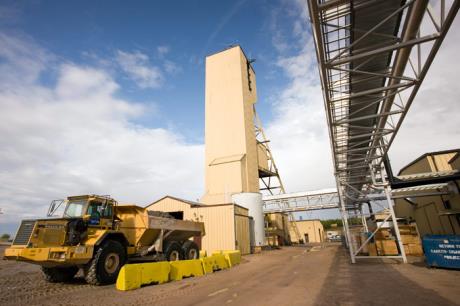Cameco expects that the Cigar Lake mine will produce between 6 and 8 million pounds of uranium oxide (2308 to 3077 tU) this year. The mine produced 340,000 pounds U3O8 in 2014, its first year of operations.
Cameco said it was providing its 2015 forecast for Cigar Lake production in order to co-ordinate with the disclosure of information by Denison Mines Corp.
 |
| Cigar Lake (Image: Cameco) |
Ore mined at Cigar Lake is transported by truck to the McClean Lake mill, operated by Areva Resources Canada Inc, where it is processed to uranium concentrate. The McClean Lake mill is located about 70 km northeast of the mine site in northern Saskatchewan, Canada. Mining at Cigar Lake began in March 2014 and the first uranium concentrate was packaged at McClean Lake in October 2014.
Cameco said it "continues to expect" Cigar Lake to ramp up to its full annual production rate of 18 million pounds (100% basis) by 2018 - with Cameco's share of that being 9 million pounds. The annual production rates during ramp-up will be adjusted as necessary based upon operating experience, it said.
The Cigar Lake mine is owned by Cameco with 50.025%, Areva Resources Canada Inc. with 37.1%, Idemitsu Canada Resources Ltd with 7.875% and Tepco Resources Inc with 5.0%. It is operated by Cameco. The McClean Lake mill is owned by Areva Resources Canada Inc with 70%, Denison Mines Inc with 22.5% and OURD Canada Co Ltd with 7.5%. It is operated by Areva.
Cameco said it will report its 2014 annual results, including 2014 production and 2015 outlook information for all other operations, after markets close on 6 February.
Mining commenced at Cigar Lake in 2014. The proven and probable ore reserves at Cigar Lake are extremely large and very high grade. A 480-metre-deep underground mine was developed in very poor ground conditions – the orebody is actually in the soft Athabasca sandstone. Hence it uses ground freezing and remotely-controlled high pressure water jets at this level to excavate the ore. Known resources are 130,000 tonnes U3O8 at about 17% average grade, and with other resources the mine is expected to have a life of at least 30 years. Production is expected to ramp up to 8,200 t/yr U3O8 (7,000 tU/yr) over four years from late 2014.
Researched and written
by World Nuclear News





_63865.jpg)
_18570.jpg)
_16159.jpg)





